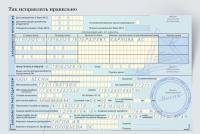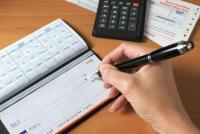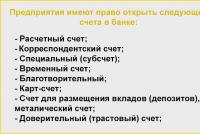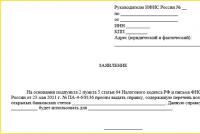How to make a linear depreciation calculation: we analyze it with an example
Linear depreciation is widely used in accounting because it is the easiest method to use. According to the Tax Code of the Russian Federation, the method of depreciation of property of the organization is chosen independently. An exception is accounting for the depreciation of fixed assets included in depreciation groups 8-10 (buildings and capital structures, housing stock, transport) - only the straight-line method is allowed to be used for them. Also, the legislation “imposes” linear depreciation on individual entrepreneurs working on OSNO.
The chosen method of writing off the cost of fixed assets must be fixed in the accounting policy of the organization, and it can no longer be changed during the useful life of the depreciable property.
Linear damping features
The undoubted advantage of this method is its "simplicity". The cost of fixed assets is simply written off over the entire period of operation in equal installments. The calculation is elementary: it is enough to know the initial cost of the property and calculate the depreciation rate once, based on the service life of the object.
Linear depreciation implements a "simplified" approach to depreciation of property. It implies that the physical condition of fixed assets deteriorates evenly, from the moment they are put into operation until the full repayment of the cost. Seasonality, intensity of use of objects are not taken into account.
This approach is most justified in taking into account the depreciation of buildings and other stationary structures. Of course, the influence of environmental factors and the mode of operation of property cannot be discounted, however, it is often impossible to accurately determine the actual percentage of depreciation of a particular object. Therefore, the method in which the cost is written off evenly and in constant amounts seems to be the most convenient for many organizations.
In the case of production equipment and other groups of actively used fixed assets, operating conditions have a significant impact on the degree of wear. Over time, their productivity decreases, repair and maintenance costs increase significantly, which can no longer be written off in the reporting period due to increased depreciation - this is not provided for by the straight-line method. If it is important for an enterprise that most of the cost of equipment be paid off in the first years of its operation, it is worth paying attention to non-linear methods of accrual, when accelerated depreciation is possible or linking depreciation deductions to the volume of manufactured products.
Straight line depreciation
When calculating in a linear way, one should be guided by the general rules for depreciation write-offs, namely:
- Having put the property on the balance sheet, from the beginning of the next month it is necessary to accrue depreciation on it.
- Repayment of depreciation amounts is made regardless of the financial performance of the enterprise.
- Deductions are made on a monthly basis and are accounted for in the tax period in which they are made.
- Conservation of a fixed asset for a period of 3 months, long-term repairs (over a year) are grounds for suspension of depreciation charges, which are resumed after the return of the property to operation from the beginning of the next month.
- The write-off for depreciation is carried out until the cost of the fixed asset is fully paid off or it is withdrawn from the balance sheet of the enterprise, the ownership of this property is lost. Accrual should be terminated at the end of the month when one of the listed events occurred.
In addition, the linear method of depreciation has its own nuances:
- the calculation is made separately for each item of fixed assets;
- only the initial cost of the property is always taken as a basis, that is, the amount of monthly deductions is calculated once after commissioning and remains unchanged for the entire useful life.
Calculation of depreciation using the straight-line method
For linear depreciation, there is a simple calculation formula:
A \u003d C * K, where
A - the monthly amount of the deduction;
C - the value of the property when it is put on the balance sheet;
K is the depreciation rate as a percentage.
Let us dwell in more detail on the depreciation rate, since with the linear method it is not established by law, but is calculated by the accounting department of the enterprise independently.
How to determine the depreciation rate? To do this, you need to know the useful life of a particular object. If the fixed asset is included in one of the 10 depreciation groups approved by the Government of the Russian Federation (Decree No. 1 of 01.01.2002), the period is taken in accordance with the group number in the classification.
For property that does not belong to any of the depreciation groups, the period of operation is established by the organization, based on the expected service life of the object, the conditions for its use, and the technical condition.
Having found out the necessary information, you can begin to calculate the norm, for which you need to use the formula:
where n is the number of months that make up the useful life of the fixed asset.
Depreciation of used property
It is far from always that completely new property is at the disposal of enterprises. Organizations often acquire used equipment or receive it on their balance sheet as a contribution to the statutory fund or, as an assignee, as a result of the reorganization of a legal entity.

Difficulties in this case should not arise. Taking into account the useful life set by the previous owner and the actual time the object was in operation, the number of years / months remaining until the end of the depreciation period of this fixed asset is calculated. The newly established service life is recorded in the accounting documents of the owner enterprise.
Example of straight-line depreciation
Consider the calculation of linear depreciation using an example.
Let's say an organization bought a computer worth 25,000 rubles for administrative purposes. The accounting department credited the PC in the month of March, therefore, April 1 is the start date for depreciation on this object.
Computer equipment is related to the 2nd depreciation group, its useful life can be set in the range from 2 to 3 years. Let's take the maximum service life - 36 months.
So, we calculate the monthly depreciation rate:
K \u003d 1/36 * 100% \u003d 2.78%
The deduction amount will be: A \u003d 25000 * 2.78% \u003d 695 rubles. (monthly).
Thus, depreciation for 9 months of operation of the fixed asset (April - December) in the amount of 6225 rubles can be included in the expenses of the current year.
As can be seen from the above example, the linear depreciation method is indeed extremely simple and will not cause problems even for an inexperienced accountant.






